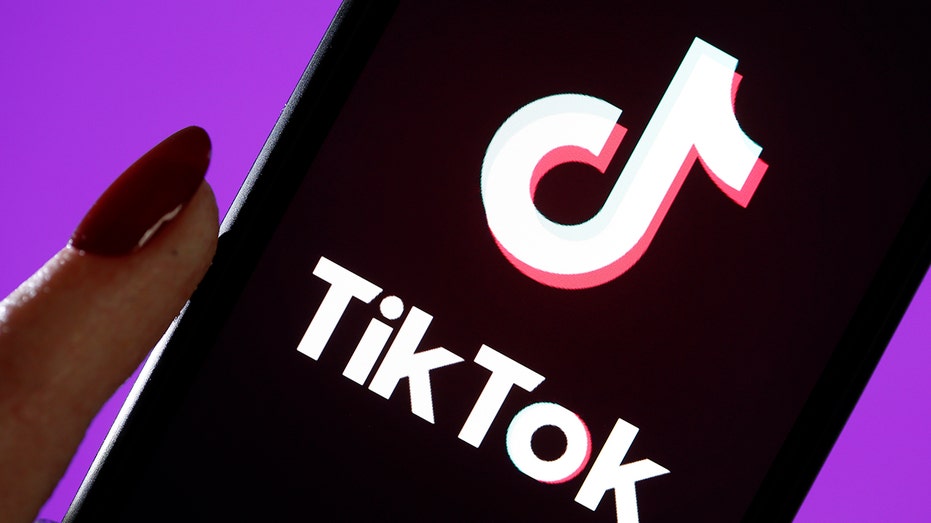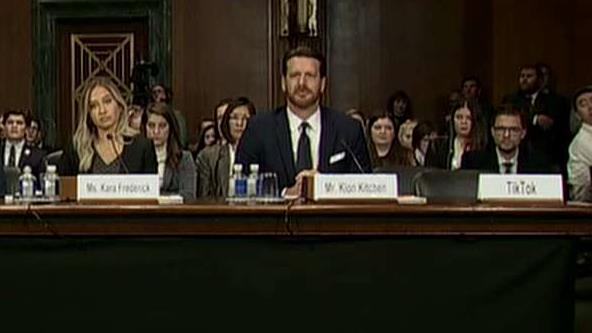Tween TikTok app obsession sparks social media safety conversations in schools
The app is most popular among kids under 16.
Teachers are taking time out of their lesson plans to talk to kids about the dangers of social media video app TikTok.
Social media safety is a trending topic in Amy Goldberg's math class at Passaic Arts and Science Charter School in New Jersey where she teaches middle school-aged kids in grades four through eight.
"I say 'every single thing you put out there can be retrieved and used again, even if you delete it,'" Goldberg told FOX Business, of her student's obsession with Tik Tok.
The free app that lets users watch and create short videos of themselves lip-syncing, dancing or telling jokes and share them with anyone on the platform.

(Photo by Chesnot/Getty Images)
The popular app, owned by Chinese parent company Bytedance, is under fire over concerns about potential national security and privacy threats it poses.
But kids and teens are already at risk.
TIKTOK A NO-SHOW AT SUBCOMMITTEE HEARING ON DATA PRIVACY
The app became the most downloaded in the world in the first quarter of 2018 with an estimated 45.8 million downloads and it has been most popular among children under 16, despite TikTok requiring users to be at least 13. If kids don't set privacy settings, anyone can view their content. This can be a major safety concern for young people, particularly if they don't have adult supervision. A BBC investigation found the app failed to remove cyber predators from the app who were sending sexually explicit messages to teens and children.
Educators "should help safeguard against exposing students to threats that abound on social media, including cruel bullying, predators, and privacy concerns," Colin Sharkey, executive director at the Association of American Educators and Association of American Educators Foundation said. "Administrators should be clear in their digital policies for staff and students, discouraging any unsupervised interaction between educators and students no matter how well-intentioned."
"Administrators should be clear in their digital policies for staff and students."
Some schools are doing their part to protect students during school hours by not allowing cell phone use, period.
US TO INVESTIGATE VIDEO-SHARING APP TIKTOK OVER NATIONAL SECURITY CONCERNS
Goldberg said cell phones are not allowed in the classroom at Passaic Charter School, and if a student is caught more than once using their phone, it's confiscated and a parent must pick it up and pay $5 each time, Goldberg explained. But students are still distracted.
Administrators "want us focusing on the standardized tests and grades, but our students are so worried about if anybody liked their photo; if someone left a mean comment; or 'so-and-so' broke up with whomever over Facebook direct message," Goldberg said. "Their minds aren't even focused on the things they're learning in class because they're thinking about if someone sent them a message on Snapchat."

And the social media obsession is affecting their mental health.
A study from Pew Research revealed that a quarter of teens aged 13 to 17 had negative effects from excessive social media use citing an increase in bullying and for its "FOMO" effect (fear of missing out), which creates feelings of low self-worth.
GET FOX BUSINESS ON THE GO BY CLICKING HERE
Social media use in the classroom
It’s impossible not to address or even use social media in the classroom with digital tablets used in many classrooms around the country, Sharkey said. Students often follow current events on Twitter, crowdsource information on Facebook or watch instructional videos on YouTube.
"Many educators cannot help but include and acknowledge social media in their effort to reach and educate our students — good or bad, it plays an influential part in modern life," Sharkey said.
Goldberg understands her students will still use social media outside of school, so she tries to make her lesson plans fun. For a recent math lesson about percentages, students were able to come up with rhyming songs Goldberg made into a video for the class to watch and to mimic the clips on TikTok.
"My students are trying to become the next YouTube viral sensation," Goldberg says.
CLICK HERE TO READ MORE ON FOX BUSINESS
Parents can do their part to monitor kid's privacy settings on apps like TikTok.
Common Sense Media, a non-profit group that helps kids and families navigate media and technology, advises parents to turn on all privacy settings for their kids' accounts so only people they know can view videos and messages on the app. This can be done by setting the account to private and changing the settings for comments and messages to "Friends" instead of "Everyone."
Teenage access to social media use has dramatically increased in the past six years.
The number of teens using a smartphone has more than doubled since 2012 from 41 percent up to 89 percent, according to a 2018 report from Common Sense Education. What's more, 70 percent of teens reported using social media more than once a day last year, compared to 34 percent of teens since 2012, and 27 percent of students age 13 through 17 report using social media hourly, according to the same report.




















